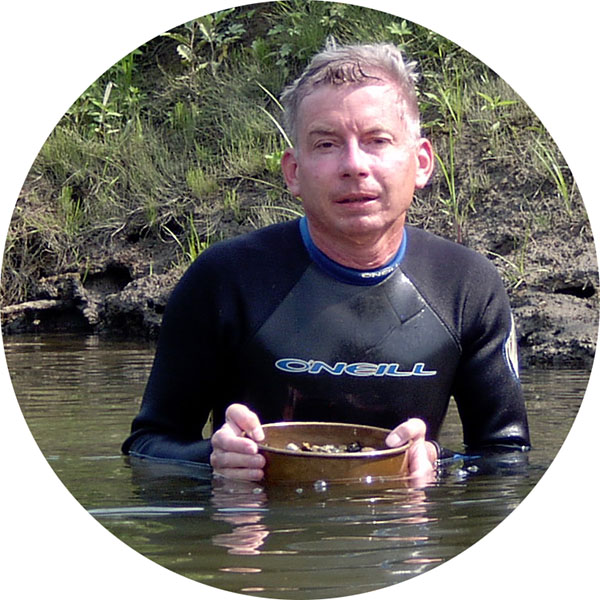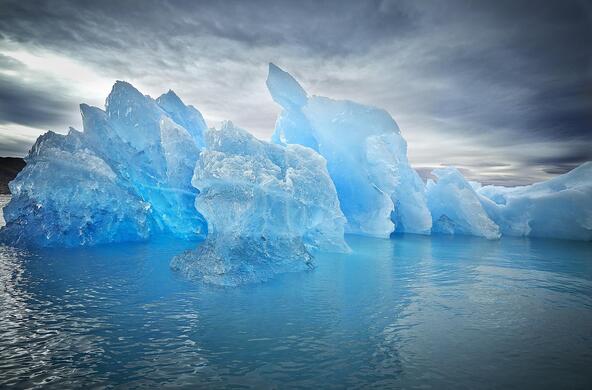July is our warmest month, its steamy days and sticky nights giving us a little taste of the tropics. When we look for ways to beat July’s heat, we often end up in the water – sprinklers, backyard pools, or one of Michigan’s many lakes. Even little kids know to head for water in the summer, but few of us understand why water is so cool and refreshing, or know just how frigid Michigan’s waters can be on the hottest summer day. So let’s take a few minutes on this hot July day to think about how cool water is.
First, water has the highest heat capacity of any substance you are likely to encounter in your everyday life, which means that it can absorb a LOT of heat without heating up much. It also transfers heat much faster than air. This explains why you cool down so much faster in a cool lake than in cool air, and warm up faster in a warm shower than in a warm room (and is the basis for that old bar bet that an ice cube melts faster at 60 degrees than at 70 degrees – put one ice cube on the counter in 70 degree air and the second in a big glass of 60 degree water, and watch what happens). Water is very, very good at absorbing heat from your suffering, sweaty body.
Second, when water evaporates, it absorbs even more heat. Evaporation is what makes you shiver when you step out of the water into a summer breeze.
The high heat capacity and cooling power of evaporation work on bodies of water as well as your body. Bodies of water are slow to warm up, even under a blazing summer sun, and are constantly cooled by evaporation. This leads us to the third reason that water feels cool – it feels cool because it is cool. In July, temperatures of lakes and streams often are much lower than the air.
This temperature difference can be large, as anyone who has gone swimming in Lake Michigan or Lake Superior (brrr) knows. The average July surface temperatures in these lakes are 67 degrees and 53 degrees, respectively, which is cooler than the average air temperatures in Lansing (72 degrees) or Marquette (66 degrees). More important to those of us seeking relief from the summer heat, the lakes are a lot cooler than the air on warm July afternoons, which typically are in the 80s in lower Michigan and in the 70s even in the U.P.
Some waters are even colder than this in July, but we don’t often encounter them. Springs and seeps that emerge from deep soils and aquifers usually run year-round at about the average annual air temperature (from the low 40s to the low 50s, depending on where you are in Michigan). Spring-fed streams can be achingly cold, even in July. Trout seek out these cool refuges on the hottest summer days, and so do anglers. People used to use springs as refrigerators, building little springhouses (see the picture) over cold springs to keep meat, produce, and dairy products cool.
The surface waters of our deep lakes may be pleasantly cool in July, but their bottom waters are downright cold. The deep waters of both Lakes Michigan and Superior are 39 degrees during the summer, no matter how hot the air is. Even small Michigan lakes have bottom waters in the 50s, if they are deep enough. Where does this frigid water come from?
Like most substances, water becomes less dense as it warms up. Water is densest at about 39 degrees, where a cubic foot of water weighs 62 pounds, 6¾ ounces. At 50 degrees, that cubic foot of water weighs 62 pounds, 6½ ounces, and at 80 degrees, it’s 62 pounds, 3½ ounces. These tiny differences have big effects on lake physics and biology.
In the spring, the sun warms the surface waters a little. At first, winds are able to mix this slightly warmer, slightly lighter surface water into the rest of the lake, and the whole lake warms from top to bottom. If the lake is deep enough, though, eventually the surface waters become so light that winds can no longer stir them down. Even a difference of a few ounces per cubic foot can be enough to defeat the wind. Once this happens, the lake becomes “stratified” – the surface waters continue to warm up, but the deep waters (which lake ecologists call the “hypolimnion”, meaning underlake) become insulated from the heating power of the sun and warm summer air. The underlake stays insulated from the heat until surface waters cool enough in the fall to allow the wind to again mix the lake. As a result, the deep waters of the lake can stay very cold all summer.
As the climate warms, lakes stratify earlier in the spring and stay stratified later into the fall, so coldwater fishes have to stay longer and longer in that sealed room.
Stratified lakes thus provide a summer refuge for coldwater fish like trout, whitefish, and smelt that would otherwise not be able to tolerate Michigan’s summers. But this refuge can also be a trap. Because the underlake is isolated from the air and the sunlight, it does not receive new stores of oxygen during the summer. It’s as if the trout and whitefish are locked in a sealed room all summer, hoping that there is enough oxygen to see them through until the room is opened again in the fall. They can’t go to the upper parts of the lake to breathe because it’s too warm. But if the underlake is small, or especially if there is too much juicy plankton settling down from the upper waters of the lake and decaying in the underlake, oxygen will run out before the fall, and the fish will die. In most Michigan lakes, especially where a rich plankton is fed by nutrients running off from lakeside houses and lawns, oxygen runs out before the end of the summer. These lakes cannot support coldwater fish, even though the underlake stays cold.
Humans are damaging these cool refuges in several ways. Climate change is warming our lakes, so the Great Lakes are now breaking records for warm summers and falls. There are subtler effects as well. I already noted that nutrient pollution leads to oxygen depletion in the underlake, squeezing coldwater fishes between overheating and suffocation. Coldwater fishes are being squeezed in another way, too. As the climate warms, lakes stratify earlier in the spring and stay stratified later into the fall, so coldwater fishes have to stay longer and longer in that sealed room. And groundwater-fed springs and seeps dry up when we pump too much ground water out of aquifers or build too many hard surfaces (roads, parking lots, roofs) that cause rain and snow to run off instead of replenishing those aquifers. Like our other natural resources, coldwater refuges require careful management if we are to preserve them.
Glaciers left Michigan more than 10,000 years ago, and it has been a long time since any Michigander felt a cooling breeze coming off a glacier. But the glaciers did leave Michigan with thousands of lakes, and deep deposits of sand and gravel that are filled with cool ground water. These legacies of the ancient ice sheets still keep us cool through July’s hottest days.







